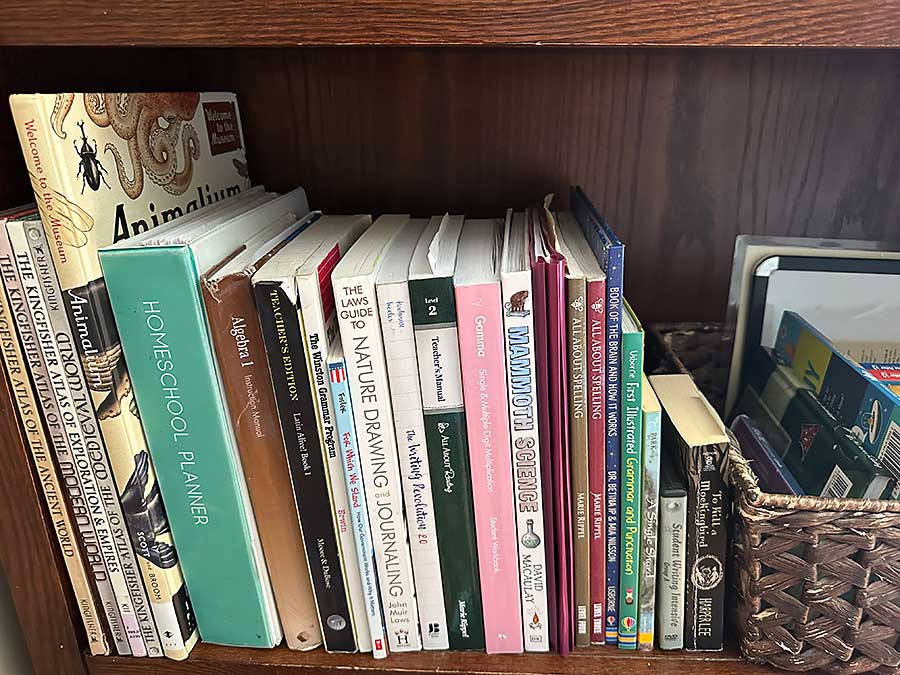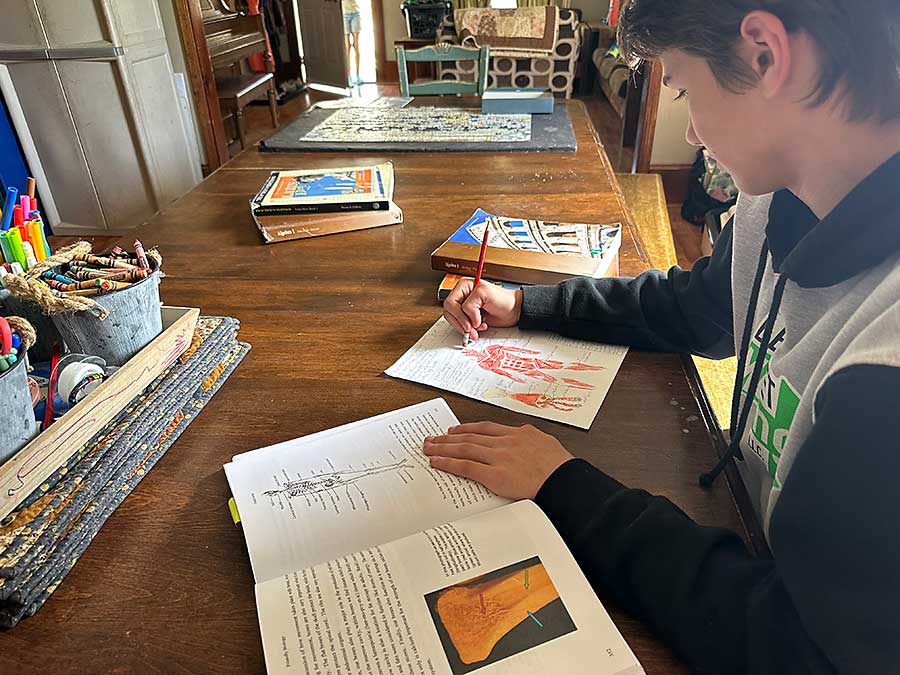
Let’s get brutally honest: no single curriculum is ever going to save your homeschool, fix your child’s attitude, or turn your kitchen into one of those magical, Instagram-perfect learning havens. If you’re looking for the “unicorn curriculum,” keep dreaming (or better yet, listen up—because we’re about to set you free).
In this episode of Homeschool Better Together, I sat down with the queen of curriculum experimentation, Laney Homan—our Community Success Manager, veteran homeschool mom of eight, and half-marathon runner (yes, we’re still impressed!).
Together, we pull back the curtain on what really makes curriculum work in a real-life homeschool, how to shop smarter (hello, shelves full of unused programs), and the hard truth about independence and motivation—for kids and parents alike.
Links and Resources From Today’s Show
- All About Reading
- Phonics Museum (Veritas Press)
- Homeschool Consistency Bootcamp
- Wonder Studies and Together Curriculum Line
- Teens on Track
- Teen Task Card MasterClass
- Put Your Homeschool Year on Autopilot
- Homeschool Better Together Community
What You’ll Learn About Homeschool Curriculum
- What happens when you stop endlessly chasing “the perfect” and start shopping for curriculum that fits your real goals (and real kids)
- How shifting your curriculum approach can lead to better results, fewer tears, and way less guilt-shopping
- Why independence can’t be bought (no matter how “open-and-go” something claims to be)
- The exact way Laney pivots when a program stops working (hint: it’s not about “fancy” or new, it’s about needs)
- How curriculum is really a TOOL, not a magic wand, and how to think like a confident homeschool parent who’s in the driver’s seat
- The value of togetherness and why our “Together” curriculum line is saving the sanity of big families and moms with laundry piles as tall as their teens
The Perfect Curriculum Is a Myth—Here’s the Real Secret to Making Homeschool Work
Let me guess: You’ve got a shelf (or seven) crammed with unused curriculum—half of it still shrink-wrapped and all of it promising to revolutionize your homeschool. Meanwhile, your real life looks more like “Where did I put that math book?” and “Why is everyone crying before lunch?”
You’re not alone. I’ve lived this story, bought all the books, and finally dragged myself out the other side—a little poorer, a lot wiser, and way less interested in chasing after the next magical program.
And if you think you’re the only one shuffling curriculum around like Tetris pieces in search of “the one”… let’s get real!
Recently, I sat down on the podcast with my good friend Laney Homan—mom of eight, half-marathoner (she’s humble, but it’s true), our Community Success Manager, and a seasoned veteran of the Curriculum Olympics. Laney has tried more programs in two decades of homeschooling than I have pairs of fuzzy socks. If you’re looking for brutal honesty and practical help, her overflowing bookshelves are a cautionary tale and a treasure chest rolled into one.
Why We Keep Chasing Unicorns
Here’s why we moms start our homeschool journey shopping for program after program after program: We think there’s a golden ticket out there—one that will make everyone happy, keep us organized, and produce kids who not only love learning, but also put their shoes on without being asked.
If only.
Laney pegged it perfectly: “Every year, I’d go straight to shopping. I was plugging in more programs as if one was magically going to fix it all.” You know what changed for her? (And honestly, for me too.) She stopped shopping for curriculum first and started figuring out what her kids actually needed.
What were their goals? What were their struggles? What did she really have the energy to teach? Suddenly, purchases aligned with reality, not fantasy. And things started working a whole lot better.
The Gritty Truth: The Best Curriculum Is the One That Gets Done
Let’s rip off the Band-Aid: The single best program isn’t the prettiest, newest, or most raved about on Facebook. It’s whatever you actually use—day after day, in your real house, with your real kids.

The best curriculum is the one that gets done. If you hate the teacher’s manual, your kid hates the lessons, or you need so many craft supplies you start hoarding toilet paper rolls, it’s never going to happen. End of story.
And let’s talk about those promises—independence, motivation, magic results in just ten minutes a day. Here’s the hard truth: No curriculum will ever take the sin nature out of your child. (That gem comes courtesy of our friend Colleen Rein, and I’ve basically painted it above my desk.)
You can switch phonics programs, buy all the math games, switch to a new writing curriculum… and guess what? There will still be pushback. Struggles. “This is dumb,” mumbled under someone’s breath. (Okay, maybe even yours.)
When Is It Time to Switch?
Laney shared a real-life example: her youngest was struggling with reading. After using the same solid phonics program with multiple kids (Phonics Museum by Veritas Press), her daughter just wasn’t making progress. Enter diagnosis: dyslexia. Enter new curriculum: All About Reading.
Did it fix everything overnight? Nope. Did reading instantly become everyone’s favorite? Sorry. Even with the “better fit,” there were still tears, slow days, and honest-to-goodness “I don’t want to” moments.
Here’s the point: Sometimes, switching is the right call. Sometimes, it’s a question of finding a program that fits your kid’s learning style, maturity, or special needs. And sometimes—this one hurts—it’s not a curriculum issue at all. It’s just parenting, patience, and the slow work of showing up.
Will Curriculum Finally Make My Kid Independent?
Short answer: No.
Someday, yes, your kids will work on their own more… when they’re older, more mature, and after you’ve taught them how. But even then? “Independence” is usually a parent job. You, the parent, are always the buffer—the translator, the cheerleader, the one who sticks post-it notes in the right chapter.
Want a hidden truth? Most curriculum is written to and for you, not your kid. They need you to teach, to prompt, to check, and to, yes, sometimes sit right next to them (Susan Wise Bauer calls this “at elbow” work; I call it reality).
And the stuff they can do independently? It’s only because you taught, practiced, and helped them master it first.
The Power of Together
One of the game changers in Laney’s homeschool has been family-style curriculum—what we at Homeschool Better Together call our “Together” line. Language arts, geography, science—everyone gathered at the table, digging into rich discussions, sharing ideas, and building sibling relationships in the process.
No more running room-to-room like a substitute teacher trying desperately to stay ahead of escapees. Instead? Do what you have the time and energy for. Then, save your individual lessons for the handful of things that truly need one-on-one attention (think phonics, math instruction, or writing feedback). For the rest, gather, connect, and save your sanity.

Use What You Own—Shop Your Shelf
Laney has kept every program she’s ever bought (“True story!” she laughs), and these days, she shops her own shelves before she shops online. If you already own it and it meets your child’s current need? It’s the right curriculum (and better for your budget).
Think:
- Does this fit my kid’s goals this year?
- Will I actually use it, or am I just hopeful?
- Who do I need to show up for—my child, myself, or maybe both?
And remember: Your child doesn’t know about all those shiny new programs online unless you tell them. If you won’t use it, don’t buy it. Guilt not required.
Choosing Curriculum Is About You, Too
We like to imagine we’re doing this “just for the kids”—but let’s be real: If you loathe the hands-on crafts, you will never do them. And if a program is prepped within an inch of its life, but it takes too much parent bandwidth, that thing’s going to gather dust.
It isn’t selfish to take your needs into account. In fact, it’s the only way to ensure you’ll actually show up, day after day. Your kids can only thrive in a homeschool that exists—not a fantasy one you’re too frazzled to recreate.
The Recap (Because You Have 10 Tabs Open):
- The right program is the one that gets done
- Curriculum won’t fix heart issues (for them… or you)
- You are the buffer—always
- Life is better with together subjects (Morning Time for the win)
- Shop your shelf before you shop online
- Your sanity matters as much as theirs
So, next time you feel that urge to buy just one more program in your (literal) cart—pause. Set your intention, make your plan, and grab what you’ll truly use. The best lessons often happen in the simple, repeated, consistent days—never in the fantasy world of “just one more curriculum.”
Want more?
- Listen to the full podcast for mom-tested curriculum wisdom and plenty of laughs!
- Check out our Wonder Studies or Together Curriculum lines to simplify your homeschool.
- Learn the 6 questions EVERY curriculum shopper should ask (next episode!).
- Join our free supportive community for more real-life encouragement and zero guilt.
You, my friend, do not need to be perfect. You just need to keep showing up.
Leave a Rating or Review
Doing so helps me get the word out about the podcast. iTunes bases their search results on positive ratings, so it really is a blessing — and it’s easy!
- Click on this link to go to the podcast main page.
- Click on Listen on Apple Podcasts under the podcast name.
- Once your iTunes has launched and you are on the podcast page, click on Ratings and Review under the podcast name. There you can leave either or both!
- Which Homeschool Schedule Actually Works for You? - June 3, 2025
- How to Keep Homeschool Consistent When Life Isn’t - May 20, 2025
- Six Smart Questions to Ask Before You Buy Curriculum - May 6, 2025
